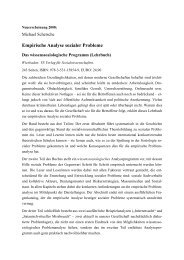Psychophysiology of False Memories in a Deese-Roediger ... - IGPP
Psychophysiology of False Memories in a Deese-Roediger ... - IGPP
Psychophysiology of False Memories in a Deese-Roediger ... - IGPP
You also want an ePaper? Increase the reach of your titles
YUMPU automatically turns print PDFs into web optimized ePapers that Google loves.
<strong>Psychophysiology</strong> <strong>of</strong> Visual <strong>False</strong> <strong>Memories</strong><br />
(2) Retention <strong>in</strong>terval: after a short pause, participants were asked<br />
to fill <strong>in</strong> the Tellegen Absorption Scale, which was announced<br />
as the second experiment (see cover story). The mean duration<br />
<strong>of</strong> the retention <strong>in</strong>terval (def<strong>in</strong>ed as time between the end <strong>of</strong><br />
the study phase and the beg<strong>in</strong> <strong>of</strong> the recognition phase) was<br />
27 m<strong>in</strong> (SD = 4:50 m<strong>in</strong>).<br />
(3) Recognition phase: subjects were then led back to the<br />
experimental chamber and connected to the polygraph leads.<br />
A written <strong>in</strong>struction asked them to decide, if the follow<strong>in</strong>g<br />
pictures had been <strong>in</strong>cluded <strong>in</strong> a visual scene from the ‘‘first<br />
experiment’’. They were <strong>in</strong>structed to first read the title<br />
head<strong>in</strong>g <strong>of</strong> each picture announc<strong>in</strong>g the different scenes (e.g.<br />
‘‘clean<strong>in</strong>g’’). A grey question box say<strong>in</strong>g ‘‘Did you see this<br />
object?’’ was presented together with each title head<strong>in</strong>g. Then<br />
they had to a look at the presented picture (e.g. a broom) and<br />
give a yes-or-no answer by press<strong>in</strong>g the respective key on the<br />
keyboard as soon as two <strong>in</strong>dication fields appeared on the<br />
screen. Answers had to be given as quickly as possible by<br />
press<strong>in</strong>g one <strong>of</strong> the two response keys. Key assignment was<br />
balanced across subjects. The given ‘‘yes’’ or ‘‘no’’ answer was<br />
marked at the respective <strong>in</strong>dication field and rema<strong>in</strong>ed visible<br />
on the screen as long as the item question was presented.<br />
The ma<strong>in</strong> run commenced after a short tra<strong>in</strong><strong>in</strong>g phase. The<br />
entire presentation time for each item, title, and question box was<br />
11 seconds. The <strong>in</strong>dication fields were presented six seconds after<br />
trial onset and stayed until the end <strong>of</strong> the trial. Each trial was<br />
followed by an <strong>in</strong>terstimulus <strong>in</strong>terval <strong>of</strong> 562 seconds (jitter);<br />
result<strong>in</strong>g <strong>in</strong> a stimulus onset asynchrony <strong>of</strong> 16 to 18 seconds. The<br />
order <strong>of</strong> the presented categories was identical to the study phase.<br />
Related lures/related controls were never presented first; the first<br />
item <strong>of</strong> each category was discarded from evaluation.<br />
The experimental procedure is depicted <strong>in</strong> figure 1.<br />
Physiological record<strong>in</strong>g<br />
Subjects sat <strong>in</strong> an upright position <strong>in</strong> order to comfortably see<br />
the monitor and reach the keyboard. Temperature <strong>in</strong> the cab<strong>in</strong><br />
was 21.460.9uC at the beg<strong>in</strong>n<strong>in</strong>g <strong>of</strong> the recognition phase’s ma<strong>in</strong><br />
run, with a maximum <strong>in</strong>crease <strong>of</strong> 1.6uC over the course <strong>of</strong> the<br />
record<strong>in</strong>g.<br />
Sk<strong>in</strong> conductance, respiratory activity, electrocardiogram, and<br />
f<strong>in</strong>ger plethysmogram were recorded. Physiological measures were<br />
A/D-converted and logged by the Physiological Data System I 410-<br />
BCS manufactured by J&J eng<strong>in</strong>eer<strong>in</strong>g (Poulsbo, Wash<strong>in</strong>gton). The<br />
A/D-convert<strong>in</strong>g resolution was 14 bit, allow<strong>in</strong>g sk<strong>in</strong> conductance<br />
to be measured with a resolution <strong>of</strong> 0.01 mS. All data were<br />
sampled with 510 Hz. Triggers <strong>in</strong>dicat<strong>in</strong>g question onsets were<br />
registered with the same sampl<strong>in</strong>g frequency.<br />
For sk<strong>in</strong>-conductance record<strong>in</strong>gs, standard silver/silver chloride<br />
electrodes (Hellige; diameter 0.8 cm), isotonic signa electrode<br />
creme (Parker Laboratories Inc.) and a constant voltage <strong>of</strong> 0.5 volts<br />
were used. The electrodes were fixed at thenar and hypothenar<br />
Figure 1. Schematic illustration <strong>of</strong> all experimental phases. Overview <strong>of</strong> experimental phases for both groups. In this example, the broom is a<br />
related lure (eg)/related control (cg), the shovel and the bucket are studied items, and the apple is an unrelated item. The study phase conta<strong>in</strong>ed 13<br />
color pictures show<strong>in</strong>g everyday scenes, the recognition phase conta<strong>in</strong>ed six items per category: three studied items, two unrelated lures and one<br />
related lure/related control. Object pictures were downloaded from the ‘‘Creative Commons/Public Doma<strong>in</strong>’’ licensed homepage ‘‘www.openclipart.<br />
org’’ and are vicarious for the copyright protected stimuli used <strong>in</strong> this study (cp. Appendix S1).<br />
doi:10.1371/journal.pone.0030416.g001<br />
PLoS ONE | www.plosone.org 4 January 2012 | Volume 7 | Issue 1 | e30416


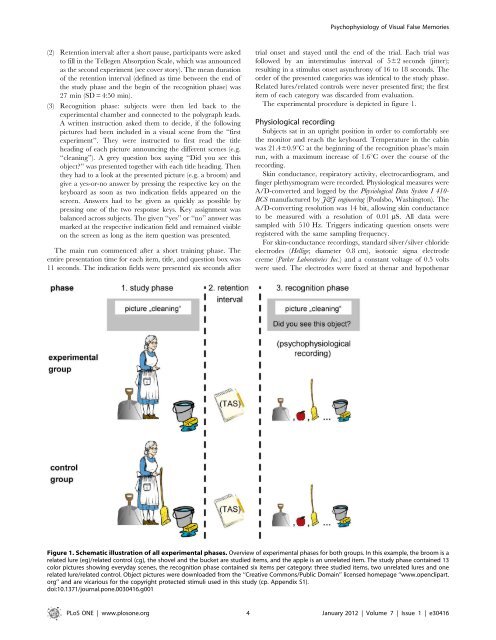
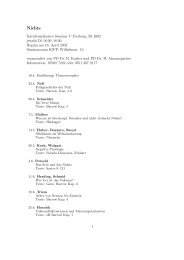
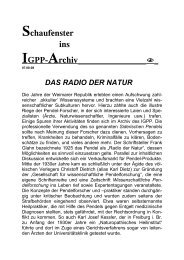
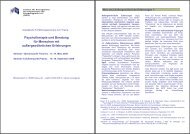
![Findliste Nachträge1 [pdf] - IGPP](https://img.yumpu.com/22552359/1/184x260/findliste-nachtrage1-pdf-igpp.jpg?quality=85)

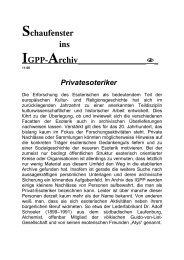
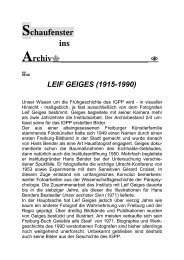
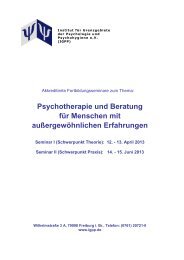
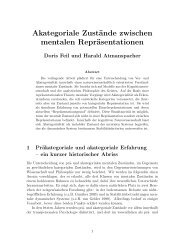
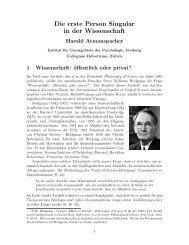
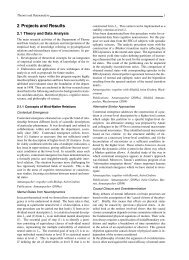
![Findliste [pdf] - IGPP](https://img.yumpu.com/22552265/1/190x245/findliste-pdf-igpp.jpg?quality=85)

